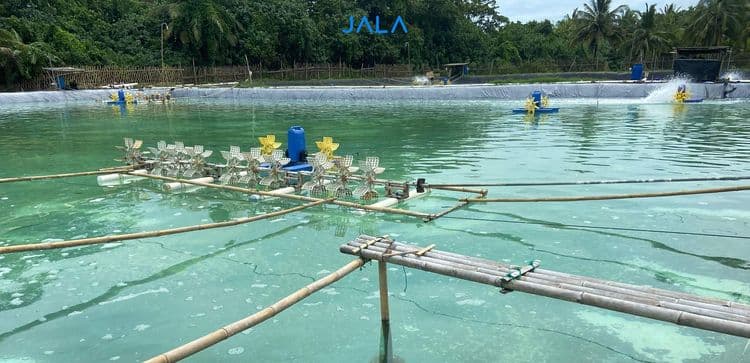
Harvesting is a thrilling step in cultivation for farmers, as it is a defining moment that shows whether the cultivation is successful. For every harvest, one of the most important equipment is the net.
Nets come in two types among others: the cast net and drag net. Let’s learn their uses and differences.
Cast net
The cast net is a commonly used catching device for fish in swamps, ponds, or rivers. It is matted with nylon, creating regular mesh sizes. Cast nets are also equipped with a weight on its side.

Cast nets are usually used in shrimp farms during sampling or partial harvest. The mesh size of cast nets has a diameter of 0.5-1 inch, or adjusted to the size of shrimp to be caught. Partial harvesting is usually done when each shrimp reaches 10-13 grams in weight. The cast net is generally 4.5 meters long.
What is partial harvesting?
Partial harvesting is a strategy to speed up shrimp growth and increase productivity. The remaining shrimp will have lower competition for feed, and are thus able to grow faster. Partial harvesting also reduces the risk of disease due to high shrimp density. It maintains the water quality and lengthens cultivation duration.
To reduce the amount of shrimp that is not caught, the mesh size can be reduced to 1 or 0.5 inches as needed. Also, the end of the net needs to have a weight with a purse line to trap the shrimp and prevent them from being released back into the pond.
Tips for harvesting with a cast net
The best way to cast a net is using the fold technique from the top until only 1.25 meters of the net remains. Place the weight behind both elbows. For the net to spread evenly when cast, ensure it is stretched well and not tangled. Harvesting using cast nets is done without reducing water to prevent overstressing the shrimp. It is best conducted under low temperature and shady weather conditions, hence in the morning. Moreover, check that the bottom of the pond where you will harvest does not have too many sediments, as they may be stirred up by the net.
Drag net or bag net
A drag net is only used during total harvesting. It is 6 meters in length with a permanent line in the front and a non-permanent one in the back. Drag nets are placed in outlet channels, in front of the pond gates to catch shrimp that is carried by the currents.

The use of drag nets or bag nets is rarely found nowadays although it is pretty efficient due to the less time and effort required. Harvesting with drag nets might not help catch all the shrimp as there might still be some that remains in the pond. The remaining shrimp will be caught with cast nets or manually by hand.

Cast nets are used during total harvesting. It requires reduction of water by considering the shrimp biomass to prevent stress in the shrimp. The higher the water, the longer the harvesting time.
As shown above, the use of nets for harvesting is not a matter to be overlooked. The type of net used depends on whether the harvesting is done partially or completely. Choosing the suitable type of net ensures harvesting is done efficiently, without losing too much shrimp from the net which may cause injury, stress, or death. Moreover, the use of nets requires proper skills.





